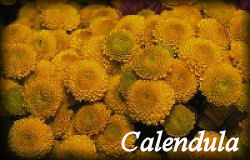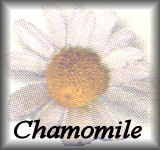Plant Chamomile in a sunny location in light, dry soil. Sow after last spring frost with about 6 inches between plants. Gather the above ground parts as soon as flowers bloom, dry for later herb use.
Chamomile is one of the most widely used flowers for herbal tea. Many people use it for insomnia as well as many other nervous conditions.
Chamomile tea:
Add 2 tsp. dried flowers to 1 cup boiling water. Steep covered for 10 min.
CINNAMON BARK (Cinnamomum zeylanicum)
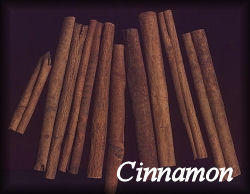 | Cinnamon is a small evergreen tree native to tropical southern India and Sri Lanka. There are two kinds of cinnamon. Cinnamomum cassia, and cinnamon zeylanicum. Cinnamomum cassia is stronger and more spicy than cinnamon zeylanicum. Its name comes from the Greek word kassia, meaning "strip off the bark".
This tree can grow up to 30 feet high. Flowers appear in summer followed by berries.
There are many ways to enjoy cinnamon. Sprinkle it on French toast, applepie, rice pudding and baked goods. You can also add cinnamon sticks to coffee and teas. |
To make your own cinnamon tea pour 1 cup of hot water over a scant 1 teaspoon of cinnamon bark. Let steep, covered, for 10 minutes, then strain before drinking.CLOVES (Syzygium aromaticum)
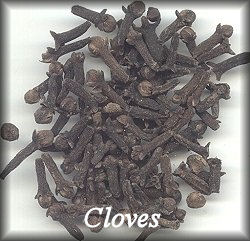 | Cloves, which gives you a sharp and spicy flavor, are the dried flower buds of the evergreen clove tree.
Cloves is native to Indonesia and can grow up to 25 feet high.
The leaves are bright green and leathery and grow to 5 inches long in pairs. The flowers are bell-shaped red and white when in bloom.
The name clove, comes from the Latin word clavus “nail” (because of shape resemblance). |
In the Middle Ages people studded oranges with cloves as a protection against plague. They believed that this would ward off bad luck. Today a lot of people do it to add a pleasing aroma to a room.
To determine whether a clove is fresh or not, put them in water. If the cloves float vertically or sink to the bottom they are fresh.
Jewish people smell cloves in the service that closes the Sabbath (Havdalah).You can use cloves in baking and to give flavor to preserved meat.
BASIL (Ocimum basilicum)
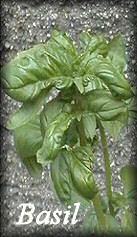
This herb is native to India, Africa and Asia and is a member of the mint family.
Basil is also known as St. Josephwort and is an annual and comes in a wide variety of flavors, colors and sizes depending on what kind of seeds you choose. For example if you are looking for a basil with color you should choose Red Rubin, Dark Opal, Osmin or Purple Thai which gives you a purple basil. If you are looking for a Basil by size, Mammoth, Napoletano or Valentino is the basil for you, and if you are looking for a Basil with a different flavor you should choose Anise, Licorice, Spice, Cinnamon, Lemon or Sweet Dani.
Basil can grow up to 3 feet tall. Grow Basil in a sunny location in a moderately rich, well-drained soil. Sow after last spring frost with about 12 inches between plants. The plant matures in about 85 days.
DANDELION (Taraxacum officinale)
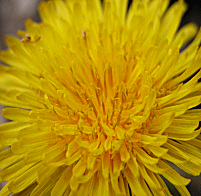 | 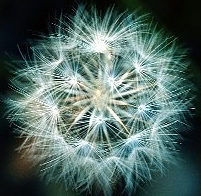 | Dandelion, also known as Lion's Teeth, has long deeply toothed leaves with bright yellow flowers that looks like a sun.
The word dandelion comes from the French "dents de lion," or "lion's teeth," because of the shape of the leaves and their color. |
Dandelion is a perennial herb native to the entire Northern Hemisphere. It is a member of the Composite family and it can grow up to 12 inches high.Dandelion is not a hard plant to find because it grows pretty much everywhere. If you haven't cut your grass in awhile, I'm sure you can find plenty of Dandelions growing there.Dandelion is a good source of potassium, phosphorus, calcium and vitamin A.There are many ways you can enjoy dandelion. Cook fresh leaves and eat it or just add it to salads. Best is if you eat them while they are young. You can also use the root in soups.
Parts used: Leaves, rhizome, roots.
ECHINACEA (Echinacea purpura)
| This herb, also known as snake root, is a very popular garden flower. It's a perennial and can grow up to 5 feet high.
Echinacea is easy to grow from seeds. It takes two years and it makes really pretty cone flowers. Grow Echinacea in fairly poor and dry soil in a sunny location.
Parts used: Rhizome, roots.
ELDER (Sambucus nigra} This herb is also known as Black Elder, Bourtree and Elderberry. The flowers are white and appears between April and July. They look like stars and they are all together in groups. The berries are blackish-purple and can be used in jellies, pies and wine. The plant can grow up to 33 feet tall. Harvest the flowers before the plant begins to blossom. Magically elder is used for exorcism, health, hex-breaking, prosperity and protection. Parts used: Bark, flowers, fruits, leaves |
EVENING PRIMROSE (Oenothera biennis)This biennial herb, also known as Fever Plant, can grow up to 4 feet high. The flowers are yellow and they usually open around seven o'clock in the evening which make this plant different from many other blooming plants. Grow Evening Primrose in fairly good sandy soil in a sunny location.The French often use Evening Primrose for garnishing salads.Part used: Bark, leaves. FENNEL (Foeniculum vulgare)
| This perennial herb has yellow flowers and is a close relative of dill. Fennel can grow up to 6 feet tall and 18 inches wide.
Grow Fennel in a sunny location in well-drained soil. Sow after last spring frost with about 10 inches between plants. The plant matures in about 90 days. Harvest the leaves and stems as needed before flowering and the seeds as they turn brown.
You can add Fennel in sauces, stews, soups, and salads and as a garnish for fish.
To make fennel tea, boil one cup of water with 2 grams of crushed seeds for 15 minutes. Keep the pot covered. Let it cool and strain. Parts used: Bulbs, seeds, stalks.FENUGREEK (Trigonella foenum-grecum)
 
This annual herb is also know as Bird's Foot, Foenugreek and Goat's Horn.
It has a bitter flavor and can grow up to 24 inches high. The leaves are cloverlike.
Fenugreek is a member of the Leguminosae family and grows wild in the Mediterranean area.
The seeds should be harvested in the fall.
The name is taken from Latin Trigonella which corresponds to the Greek trigonon meaning “triangle”, probably refering to the triangular shape of the flowers. The Latin species name foenum graecum means “Greek hay”, referring to both the intensive hay fragrance of dried fenugreek herb and its Eastern Mediterranean origin.
There are many ways you can enjoy fenugreek. Add some seeds as a flavor to pea soups, meat stew and curries.
Fenugreek contains a good amount of vitamin B.
To make fenugreek tea: use a teaspoon of whole fenugreek seeds. Steep in boiling water for 15 minutes.
GINGER (Zingiber officinale)
 | This herb, also known as African Ginger, is most famous for relieving vomiting and nausea, no matter what the cause is.
Ginger is a perennial that can grow up to 4 feet high. Grow it in a shady location.
Ginger is often used in Chinese and Indian food because it gives a hot and strong taste. |
There are many ways to enjoy ginger. You can add it to soups and stir-fried vegetables or even brew it into a tea.
GINGKO (Gingko biloba)
 | Gingko, also known as Maidenhair Tree, has been used for thousands of years by Chinese herbalists for the treatment of asthma.
Gingko is widely used in Europe to treat strokes and poor circulation in the brain. Gingko may also boost blood flow into the penis.
Today, this herb is one of the five-top selling herbs in the United States. |
|
|
GOLDENSEAL(Hydrastis canadensis) This perennial herb, also known as Yellow Root, acts as an antibiotic. Goldenseal grows in the Appalachian Mountains and surrounding areas. It is one of the most expensive herbs on the market since the plant has been largely overharvested.LAVENDER (Lavandula officinalis)
![lavender - Lavandula oofficinalis>
</TD><TD VALIGN=]()
Lavender is a perennial herb and is a member of the mint family. The flowers are purple, pink or white, and grow in whorls of six to ten flowers. The hardiest and most popular is the purple flower. The plant can grow up to 36 inches tall. |
Plant Lavender in a sunny location in light, well-drained soil. Sow 1-2 weeks before last spring frost with about 12 inches between plants. The plant matures in about 60 days. Harvest the plant just as the flowers open.
The word "Lavender" comes from the Latin "lavare" which means "to wash". According to folklore lavender is a favorite scent of the elven folk, which is why it is sometimes referred to as Elf Leaf. Magically lavender is used for peace and love.
To make lavender tea you need about 1-2 teaspoons of lavender flowers to make one cup of tea. LICORICE (Glycyrrhiza glabra)This perennial herb has been used for over 3000 years. It can grow up to 7 feet high. Licorice is 50 times sweeter than sugar so it's often used to disguise the bitter taste of medicines.NETTLE (Urtica urens)
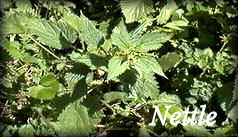 | This perennial herb is also called Stinging Nettle because it's covered with tiny hairs that contain formic acid which sting when you touch them. |
Nettle has toothed, egg-shaped, dark green leaves and it can grow up to three feet tall. The flowers are green or greenish-white which flowers from June to September.If you have been stung by a nettle it may help to rub the part with Rosemary, Mint or Sage leaves. Young leaves can be cooked for soups or can be added to salads and vegetables.To make tea of nettle, pour one cup boiling water over 3-4 teaspoons of dried nettle. Let the tea draw for for about 10 minutes. For best effect, drink 1 cup three times a day. Sweeten the tea with honey. Parts used: Leaves, stems of young plants. SAGE (Salvia officinalis)
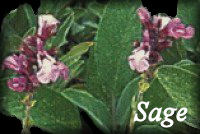 | This perennial herb, also known as edible sage or garden sage, has a strong and distinct flavor. The word sage comes from the Latin "salvare" which translates as "to heal". |
The leaves are oval and grayish green and the flowers are blue or purple and grow in whorls. Sage can grow up to 30 inches high and 24 inches wide.
Sage is very easy to grow from cuttings or seeds. Grow the herb in a sunny location in rich, well-drained soil in a sunny location. Sow 1-2 weeks before last spring frost with about 25 inches betwen plants. The plant matures in about 75 days. Harvest the leaves before the plant bloom.
There are many ways to enjoy sage. Add some dried sage leaves to vegetables like tomatoes, dried beans, onions and eggplant.
Part used: Leaves, stems and flowers. SLIPPERY ELM (Ulmus fulva)This herb is also called Moose Elm, Red Elm, and it can grow up to 60 feet tall.
Slippery Elm is well known for its ability to cleanse, and strengthen the body.
Slippery Elm Bark contain vitamins A, B complex, C, K, and P.
Magically Slippery Elm is used to cease gossip. Tie a knotted yellow thread around the Slippery Elm and throw it into a fire - all gossip about you will stop.
To make tea, boil 2 grams of the bark in 200 ml of water for 15 minutes. Let it cool. Drink three cups a day.
Part used: Inner bark.
RED RASPBERRY (Rubos idaeus)
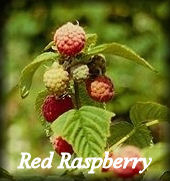 | This perennial herb can grow up to ten feet tall. The plant grows both in the wild and in cultivation. The berries, which are high in iron and vitamins A, B, C and E, are red and the leaves are oval and grows in groups of three to five.
Red Raspberry is a cousin of the rose.
Plant raspberry (best is if you buy the plant as a root stock) in a well-drained soil in a sunny location. Harvest the leaves in may and the berries as they ripen. |
To make tea of raspberry, pour one cup boiling water over 1 tablespoon dried raspberry leaves. Let the tea draw for about ten minutes.
You can also make juice and jam out of raspberry.
Parts used: Fruits, leaves.PASSIONFLOWER (Passiflora incarnata)This perennial herb is also known as Maypop, Passion Vine, Granadilla and Maracoc. It was named by Spanish explorers in South America in the 1500s because the flowers reminded them of elements of the crucifixion and symbolized, to them, the passion of Christ.
Passionflowers grows in sandy thickets, open fields, roadsides and fence rows.
Plant in a well-drained soil, sandy slightly acid soil in full sun.
The flowers are purple and white and bloom from June to August. The fruit is yellow-green when ripe.
To make tea, steep 2-3 teaspoonfuls of dried herb in 8 oz. (240ml) boiling water for 10 minutes.
Parts used: Flower, leaves and stem.
This herb may cause sleepiness in some people and should not be used before driving or operating machinery. Don't take if you are pregnant. |
|
|
|
|
How to dry herbs:There are many ways for you to dry herbs. You can air dry them, oven dry them or even microwave dry them.Air drying: Simply tie them in bunches (about 5-6 flowers in every bunch) and hang them upside-down in a dark and dry place, about 70 F. Depending on what kind of herb you are drying it can take a few days and up to weeks for them to dry completely. For thicker parts or heavier roots it may take more than a year.Oven drying: Put the herbs on a sheet in a thin layer and place them in a low setting oven.Microwave drying: Put the herbs on a plate and set the microwave on low. According to your microwave and how much herbs you have in it, it can take about 2-5 minutes.To dry leaves and flowers: Spread the leaves and flowers in a basket. This will take about 1-2 weeks before it's dried.To dry seeds: Hang bunches of flowers inside a paper bag. The dried seeds will fall down to the bottom of the bag.
The herbs are ready when they are as dry as paper and they crumble when you rub them between your fingers. Once the herbs are dry, store them in ceramic containers or in dark glass jars with tight-fitting lids because herbs will deteriorate when they get exposed to oxygen. Don't forget to put labels on your containers! Keep the herbs in a dark and cool place like a closet or a cupboard. Dried herbs can retain their medicinal value for years.
Some herbs can also be frozen. Specially herbs with soft leaves like Comfrey, Basil, Borage, Fennel, Dill and Parsley.How to make herb tea: |
